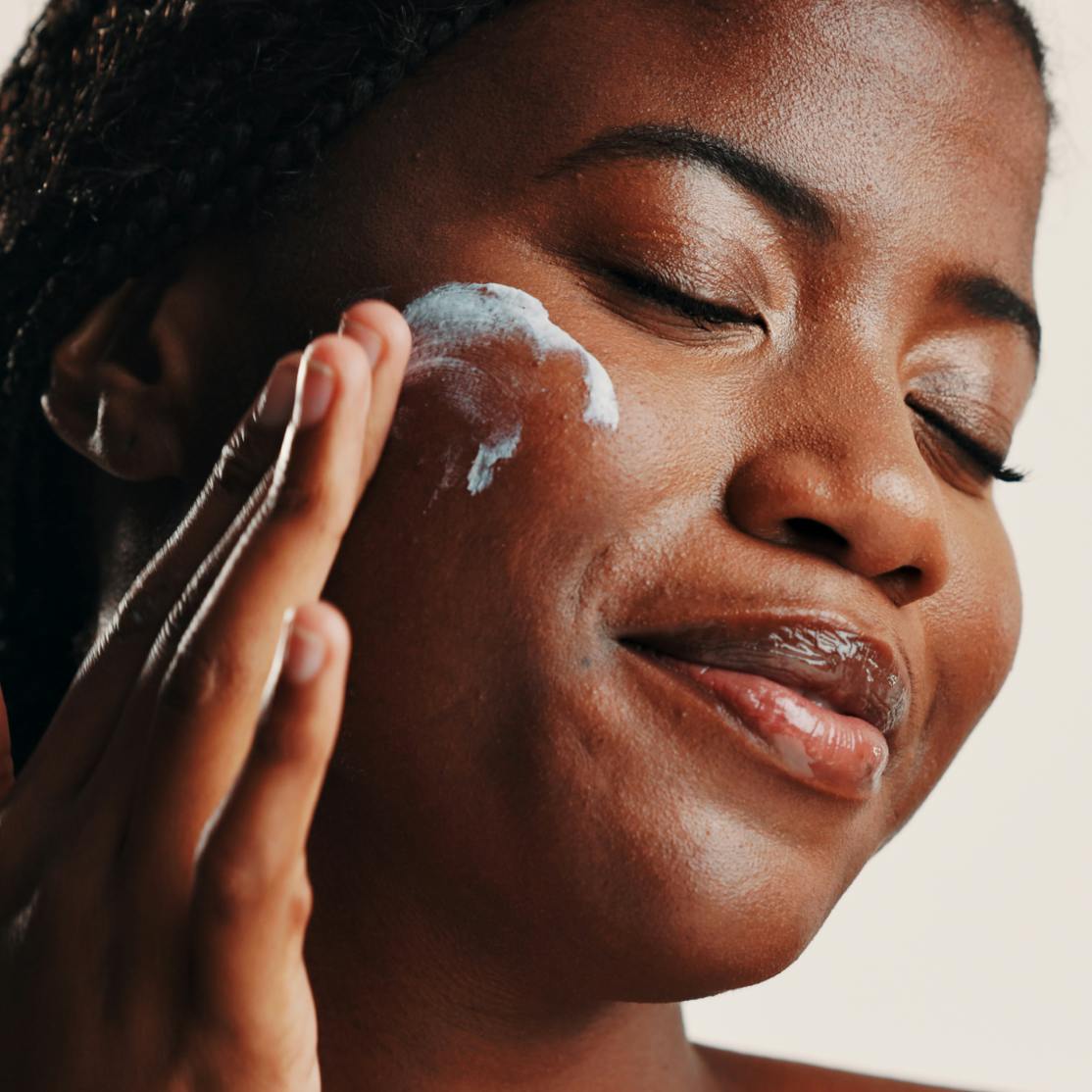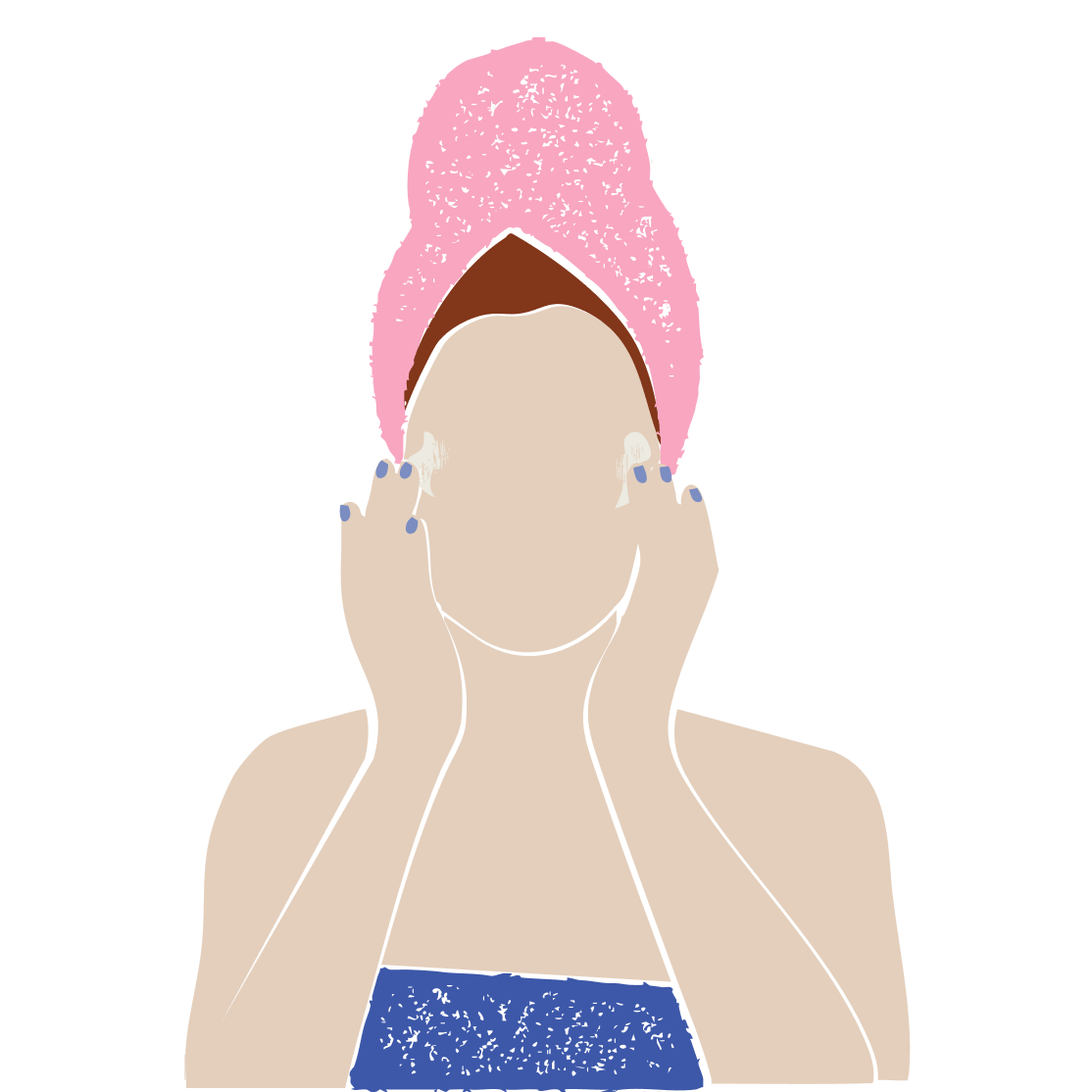Even if you give your face a lot of attention and plenty of skin care TLC, the area just beneath it is too often ignored when it comes to moisturizer, antiaging ingredients, and sun protection. The truth is, most of us don't give our neck a second thought, until it starts to look older than our face. Here, everything you need to know about what causes neck wrinkles—and what to do about them.
Most women start to notice neck wrinkles, sagging, or crepey skin (or all the above) during perimenopause, and that's when a spotlight is put on this trouble area. What's happening? And more importantly, what can you do about it? From neck wrinkle treatments to skin care products, here's the lowdown on how to get rid of neck lines naturally—and with a little help from your dermatologist.
What Causes Neck Wrinkles?
Aging and decreased collagen production
The skin on your neck (just like the skin on your face) is subject to collagen and elastin loss over time. This natural aging process, also known as senescence, also slows down skin cell turnover, which causes a pileup of dead cells on the surface of the skin that leads to dullness and worsens noticeable fine lines. This combo of events hits particularly hard during perimenopause, when estrogen levels begin to decrease.
Estrogen is a hormone that stimulates fibroblast cells in your skin to produce more collagen and elastin—the proteins that form the inner foundation of healthy skin and keep it firm and flexible. Studies show that collagen can decrease by as much as 30% in the 5 years following menopause. Lower levels of estrogen not only impact collagen and elastin, but also the production of natural hyaluronic acid (HA) and lubricating ceramides in the skin. This makes the outermost layer of the skin dry and vulnerable (especially on your neck, which already has fewer oil glands) because there are fewer natural lipids to maintain moisture in the skin.
Sun damage and UV exposure
Here's a sobering fact that will motivate you to slather on SPF: Up to 80% of signs of aging come from unprotected sun exposure. UV exposure not only causes brown spots, it also breaks down your skin's supply of precious collagen and elastin. Over time, this leads to neck wrinkles and sagging skin.
Repetitive movements and "tech neck"
Your neck makes a tremendous amount of repetitive movements. Turning side to side and looking up and down over and over make it more prone to wrinkling. Think about how many times you tuck your head down, especially looking at your phone, during the day. This crumples up the skin on the front of your neck and, over time, can lead to more creasing there. No wonder this phenomenon has earned the nickname tech neck.
Genetics and skin type
The skin on your neck is thinner and has fewer oil glands, so it tends to be drier and more delicate than the skin on most of your face, except for your eyelids. Besides physiology, heredity has a huge influence on the kind of Fitzpatrick skin type you have, which categorizes skin color and how your skin responds to the sun. When it comes to your skin's tendency to be oily or dry, the neck area is always going to be drier because it has fewer sebaceous glands.
Lifestyle factors
Here are a few things you probably already know. Simply put, smoking is the worst thing you can do for your skin (besides baking in the sun unprotected). It speeds up the aging process, damages collagen and elastin, and wildly increases oxidative stress and toxic free radicals. On the flip side, something you can do to improve your skin is simply eating a healthy diet of whole foods that are rich in nutrients like protein, healthy fats, and especially antioxidants such as vitamins C and E. These nutrients benefit your skin from head to toe.

How to Prevent Neck Wrinkles
- Regular use of sunscreen and sun protection: Consider a daily moisturizer that has broad-spectrum sunscreen with a 30 SPF or higher to be one of your best antiaging tools. Protecting the vulnerable skin on your neck is one of the most important ways to prevent UV damage that causes brown spots and wrinkles. Think of the sun's rays like laser beams, disintegrating your collagen and elastin, which directly triggers skin laxity and neck lines. Even if you've neglected sunscreen on your neck before, it's never too late to become obsessive about it—and yes, that means wearing it every single day, even cloudy ones.
- Maintaining proper hydration: While adequate hydration is essential for healthy skin functioning, drinking more water isn't necessarily going to make your skin look better or smooth out neck lines. What will make a noticeable improvement in your skin and neck wrinkling is topical hydration with moisturizing products that contain humectant ingredients like HA and glycerin. These hydrate the surface of the skin and can temporarily plump up neck lines to soften them.
- Improving posture and minimizing repetitive neck movements: While decreasing your screen time is probably a nonstarter, it helps to be aware of your posture and the position of your neck when you're working on a laptop or looking at your phone. One study even suggests that women suffer from this tech-related posture problem more than men. Try to be more mindful of this forward flexion movement and lift your phone to eye level when you can or adjust the ergonomics of your work station by raising your computer screen to eye level.
- Incorporating antioxidants into skin care and diet: Antioxidants work to prevent and repair toxic free radical damage from environmental factors like the sun and pollution. It's important to get plenty of antioxidants in your diet, such as plant-based polyphenol antioxidants in green tea, berries, fruits like apples and citrus, vegetables like broccoli and spinach, and spices such as cumin and ginger. Topical antioxidant ingredients, such as vitamins C and E, and resveratrol from grapes help neutralize free radicals in the skin and repair environmental damage.
Topical Treatments for Neck Wrinkles
Estrogen creams
Because estrogen prompts cells to make more collagen and elastin, lower estrogen levels starting in perimenopause lead to less of these important proteins in your skin. Estrogen is also important for the synthesis of HA and ceramides, the key moisturizing factors in skin. This is why skin everywhere becomes drier and laxer during menopause—and your neck is especially prone to these effects, since its skin is naturally drier and thinner.
Consider talking with your healthcare professional, like a Midi clinician, about hormone replacement therapy (HRT), which can be a game-changer in treating multiple perimenopause-related symptoms, including dry skin. Another counter to diminishing estrogen for the skin is a topical estrogen cream, like the Midi Health Estriol+ Face Cream, which contains estriol, the mildest form of topical estrogen. While this topical ingredient does not increase the level of hormones circulating throughout your body, it has been shown to help improve collagen and elastin levels in menopausal women, as well as moisturizing the skin.
Retinoids for collagen production
Retinoids like tretinoin are chemical derivatives of vitamin A. Tretinoin is the gold-standard topical ingredient for treating fine lines and skin laxity by stimulating collagen and elastin production. Research has proven that prescription-strength tretinoin penetrates the dermis and acts directly on skin cells like fibroblasts to prompt production of collagen and elastin. It also effectively treats hyperpigmentation and adult acne by regulating skin cell turnover, which starts to slow after age 30.
Retinol is a milder over-the-counter version of prescription retinoids like tretinoin. It is converted into retinoic acid in the body, so it’s a little bit more indirect and less potent. Even so, it’s proven to be very effective, though the benefits are more gradual. Numerous studies have also shown that retinol improves signs of photoaging—like wrinkles, brown spots, and skin laxity—by regulating skin cell turnover and stimulating collagen and elastin production.
Hyaluronic acid for hydration and skin plumping
Hyaluronic acid (HA) is a naturally occurring, lubricating substance in the skin—not to mention other areas of the body, including your eyes and joints. Like collagen and elastin, HA levels diminish over time. Research shows that the production of natural HA in the skin decreases starting as early as age 25, so it’s a good idea to replenish it topically with a skin care product. Topical HA is a water-binding humectant, which means that it attracts moisture to the surface of the skin. As it hydrates, it also instantly plumps and softens fine lines.
Peptides to improve skin elasticity
Peptides are short chains of amino acids that serve as building blocks for proteins like collagen. Topical peptides and polypeptides (either synthetic or plant-derived) have been linked to stimulating collagen production. For people with sensitive skin that can’t tolerate a retinoid, peptides are a good plan B because they tend to be gentle and nonirritating.
Vitamin C serums for antioxidant protection
Vitamin C is a superhero antioxidant that defends skin against toxic free radicals from environmental damage (UV rays, pollution), which destroy collagen and elastin. Topical vitamin C in the form of ascorbic acid has been shown to reduce hyperpigmentation and helps brighten skin. It’s also been proven to help stimulate collagen production, so it’s a win-win-win for neck wrinkles.
True Stories of Transformation
Professional Treatments for Neck Wrinkles

- Botox injections for vertical lines: Injectable neuromodulators like Botox work by temporarily relaxing specific muscles underneath the skin. Injecting Botox into the vertical bands in the center of the neck has been shown to relax the platysma muscle (just under the jawline) and smooths those lines. (If you clench your jaw, you will see these vertical bands.) Results typically last for 3 to 4 months.
- Dermal fillers for horizontal lines and to slenderize the neck: Dermatologists sometimes inject a tiny amount of a lightweight HA injectable filler into horizontal neck lines. The filler formula contains the humectant HA that’s naturally made by your skin, and it can help to smooth lines temporarily. Fillers do not improve the vertical neck lines impacted by platysma muscle contractions, though. Injectable filler is more typically used to help define and reshape the lower face by injecting it along your jawbone to create a more distinct jawline from ear to ear. It can also be injected into your chin to lengthen it slightly and create a stronger profile.
- Laser resurfacing treatments to stimulate collagen: Laser energy delivers heat deep into your skin by drilling microscopic holes in the epidermis with hundreds of separate, fractionated laser beams. (This way, the surface of your skin isn’t completely scorched, thanks to the minute untouched spaces amid the lasered pinholes.) Fractionated laser resurfacing treatments are proven to deliver many skin improvements. By creating a controlled wound, laser energy stimulates collagen and elastin production, which has firming and line-smoothing effects over time, and it also works to improve hyperpigmentation and dullness.
- Microneedling to improve skin texture and tone: Microneedling creates a controlled injury that triggers a wound-healing response in your skin. This prompts the fibroblast cells in skin to produce more collagen, which in turn improves texture, tone, and neck wrinkles. The needles also create multiple microscopic open channels in the skin, which is why this treatment is often immediately followed by the application of ingredients like HA, so they can be absorbed deeper into the skin.
- Ultrasound therapy (Ultherapy) for lifting and tightening: Ultrasound energy works in a similar way to laser energy: It can create a controlled injury deep in the skin (without damaging the surface) to stimulate a wound-healing and collagen-building response. Ultherapy is a noninvasive treatment that uses ultrasound energy to deliver intense heat deep into your skin, revving collagen production and tightening tissue over time. Results can typically be seen in 3 to 6 months.
Natural Remedies You Can Do At Home
Regular exfoliation and moisturizing
Remember that neck skin is more sensitive, so you don't want to go overboard with scrubbing or harsh treatments. Simply using a chemical exfoliator that contains lactic or glycolic acid will gently slough off dead skin cells to smooth the texture and even the skin tone.
Most importantly, because the skin on your neck has fewer sebaceous glands and is drier than skin elsewhere, you need to moisturize at every step. Neck skin craves a richer moisturizer that contains hydrating humectants like HA, which attracts moisture and plumps up neck lines. Your moisturizer should also have emollients like ceramides and squalene to seal in that hydration and smooth skin.
DIY masks with ingredients like aloe and honey
If you pamper your face with a moisturizing mask, then you should absolutely give your neck the same kind of TLC. Your neck cannot get enough moisture, so hydrating natural ingredients such as honey and aloe are excellent moisturizers. Both aloe and honey also have anti-inflammatory properties that soothe the sensitive skin and calm redness.
Lifestyle Adjustments for Long-Term Results

Focus on balanced nutrition rich in antioxidants
Eating a healthy diet made up of whole foods that are rich in nutrients like protein, healthy fats, and especially antioxidants (such as vitamins C and E) can benefit your skin from head to toe. Antioxidants work to prevent and repair toxic free radical damage from environmental factors like the sun and pollution.
Stop smoking and limit alcohol
Simply put, smoking is the worst thing you can do for your skin. It speeds up the aging process, damages collagen and elastin, and wildly increases oxidative stress and toxic free radicals. The carcinogens in tobacco smoke also kill off collagen, so a smoker’s skin becomes more wrinkled and less elastic than that of a nonsmoker.
Alcohol consumption also increases inflammation and dehydrates the skin, taking away plumpness. Like smoking, heavy alcohol consumption has been proven to increase skin aging. Limiting alcohol intake and quitting smoking are smart, healthy habits that can improve your overall health—and the health of your skin barrier.
Prioritize sleep and stress management
Stress and a lack of sleep take a toll on the skin. How? If you aren’t getting enough quality sleep, you’re not giving your body time to repair itself. While we sleep, our parasympathetic nervous system takes over and blood flow shifts to our skin. This is when repair mechanisms go into action, building more collagen, draining toxins, and repairing damage. Without enough rest, the skin doesn’t get this important rejuvenation, and chronic poor sleep quality has been shown to speed up skin aging and impair skin barrier function.
Sleep deprivation is actually a form of stress, and stress sends the body’s fight-or-flight mechanism into overdrive, putting the skin into a weakened state. It also releases hormones like adrenaline and cortisol, which increase your heart rate and blood pressure, suppress your immune system, and impair your protective skin barrier. Stress also amps up inflammatory reactions and has been proven to worsen skin aging.
Choosing the Best Treatment Option for You
Consult with dermatologists or skin care specialists
A good skin care routine, including daily sun protection and antiaging ingredients like retinoids and peptides, all help improve the skin on your neck, soften neck lines, and prevent collagen breakdown from UV exposure. They all work, but the results take time.
When it comes to skin laxity and deep neck wrinkles, some innovative and noninvasive cosmetic procedures may deliver more dramatic and visible results more quickly. Considering any kind of cosmetic medical procedure is a big step, however, and it requires consultation with a dermatologist or specialist. You can ask questions, see before and after photos, and learn what to expect from any kind of treatment.
Assess skin type, severity of wrinkles, and personal goals
During a consultation, a dermatologist or skin specialist should answer all your questions and assess your skin type, as well as the severity of wrinkles and skin laxity. They can also discuss your personal skin goals with you. Plus, your healthcare professional can explain the details of any procedure and discuss treatment alternatives with you. Perhaps neck Botox will be your best choice for addressing vertical neck lines, or maybe a series of fractionated laser treatments will help address skin laxity, sun damage, and neck wrinkles more effectively.
Understand the costs, risks, and benefits of treatments
During a consultation, your healthcare professional will also discuss the cost of the treatment, the risks and side effects, the downtime, and the benefits. If you’re considering a fractionated laser treatment, for example, it may entail two to three treatments spaced out over a few months. An Ultherapy procedure is usually one and done, but you don’t see the skin-tightening results for months because it takes that long for collagen and elastin to build. The costs of professional cosmetic treatments vary wildly (and most are not covered by health insurance), so it is important to ask how much one treatment—or a series of them—will cost. Your healthcare professional should be completely transparent about conveying all the information you need.
Key Takeaways
- Treat your neck like your face: No more skipping over your neck and décolletage when applying your skin care products.
- Apply SPF every single day: A daily moisturizer with broad spectrum sun protection and an SPF of 30 or higher is nonnegotiable.
- Add antioxidants, via your diet and topical products: These work to prevent and repair toxic free radical damage from environmental factors like sun and pollution.
- Apply retinoids and peptides to boost collagen: Prescription-strength retinoids like tretinoin are proven to stimulate the production of both collagen and elastin. For people with super sensitive skin that can’t tolerate a retinoid, peptides can help stimulate collagen production.
- Consider professional cosmetic treatments: When it comes to skin laxity and deep neck wrinkles, some innovative and noninvasive cosmetic procedures may deliver more dramatic and quicker results more quickly, like fractionated laser resurfacing, Ultherapy, and injectables like Botox.
Frequently Asked Questions (FAQs)
Can wrinkles on the neck go away?
With a good skin care routine—including daily broad-spectrum sun protection as well as antiaging ingredients like retinoids, peptides, and antioxidants—you can help to reduce visible neck lines. Though they may not disappear completely, you can make a real improvement in your skin.
Can neck lines be reversed?
Neck lines can be reversed with a surgical face lift (admittedly, an extreme answer), but you can greatly improve neck lines with a proactive skin care routine that includes collagen-boosting retinoids and peptides, collagen-preserving antioxidants, and daily UV protection. In addition to all of these important skin care steps, many noninvasive cosmetic procedures may deliver visible results.
How do you get deep wrinkles out of your neck?
A proactive a.m. and p.m. skin care routine that includes collagen-boosting retinoids and peptides, collagen-preserving antioxidants, and daily UV protection is your first step toward smoothing neck lines. When it comes to deep neck wrinkles, certain cosmetic procedures may deliver more dramatic and visible results more quickly. In-office procedures like fractionated laser resurfacing, Ultherapy, and injectables like Botox all work in different ways to soften deep neck wrinkles and tighten slack skin.
Can you fix your aging neck?
A skin care routine that includes neck-specific moisturizing with emollient ingredients like ceramides and hydrators such as HA can plump up neck lines and add suppleness to dry skin on the neck. Regular use of antiaging ingredients that boost collagen production can help soften neck wrinkles over time. Retinoids and peptides boost collagen and elastin, and estriol works in a slightly different way to increase the synthesis of collagen, elastin, HA, and ceramides in your skin.
What causes neck lines?
Neck wrinkles are primarily due to diminishing collagen and elastin proteins in the skin (that break down over time due to UV exposure and the natural aging process). This natural aging process, called senescence, also slows down skin cell turnover, which causes a pileup of dead cells on the surface of the skin—which can cause dullness and worsen noticeable fine lines. This combo of events hits hard during perimenopause, when estrogen levels begin to decrease. Estrogen is a hormone that stimulates fibroblast cells in the skin to produce more collagen and elastin. These proteins are the foundation of healthy skin, keeping it firm and flexible.
If you’re in perimenopause or menopause and want guidance from clinicians who specialize in women’s midlife health, book a virtual visit with Midi today.
Hormonal change is at the root of dozens of symptoms women experience in the years before and after their period stops.
Our trained menopause specialists can help you connect the dots to guide you towards safe, effective solutions.
Whether you need personalized guidance or a prescription routine to tackle symptoms—including vaginal dryness and irritation, brain fog, hot flashes, sleep trouble, mood swings, and weight gain—we’ve got you covered.
Midi’s mission is to revolutionize healthcare for women at midlife, wherever they live and whatever their health story. We believe that starts with education, to help all of us understand our always-changing bodies and health needs. Our core values guide everything we do, including standards that ensure the quality and trustworthiness of our content and editorial processes. We’re committed to providing information that is up-to-date, accurate, and relies on evidence-based research and peer-reviewed journals. For more details on our editorial process, see here.


 Amanda Alvelo-Malina, MD
Amanda Alvelo-Malina, MD





